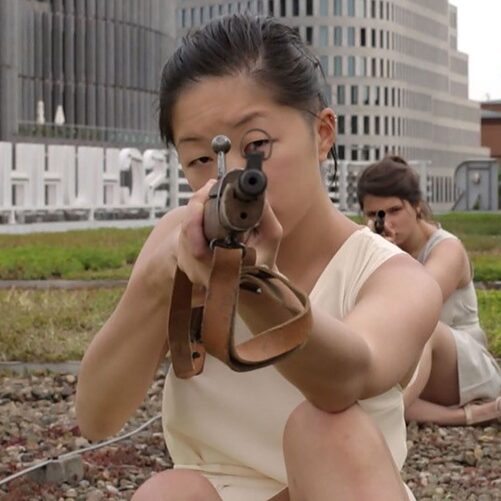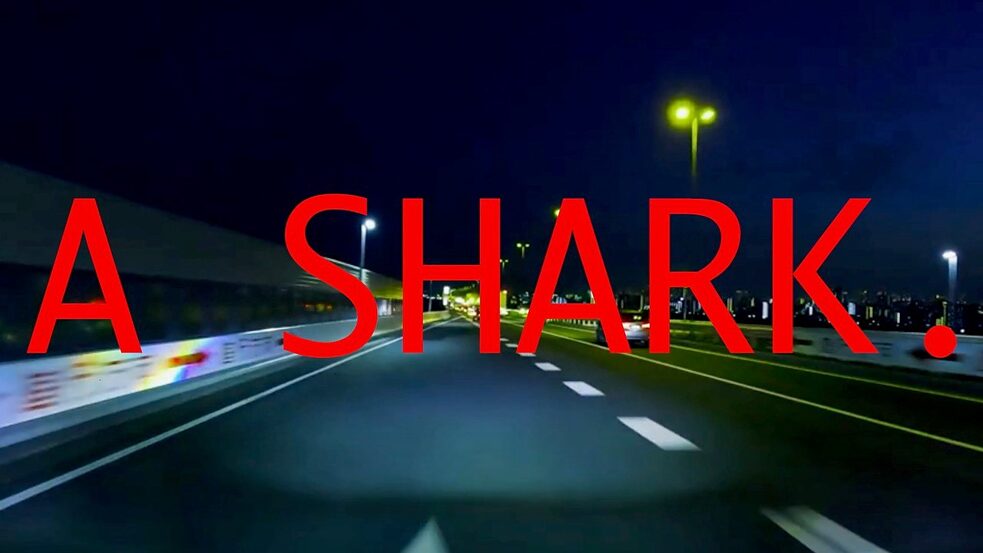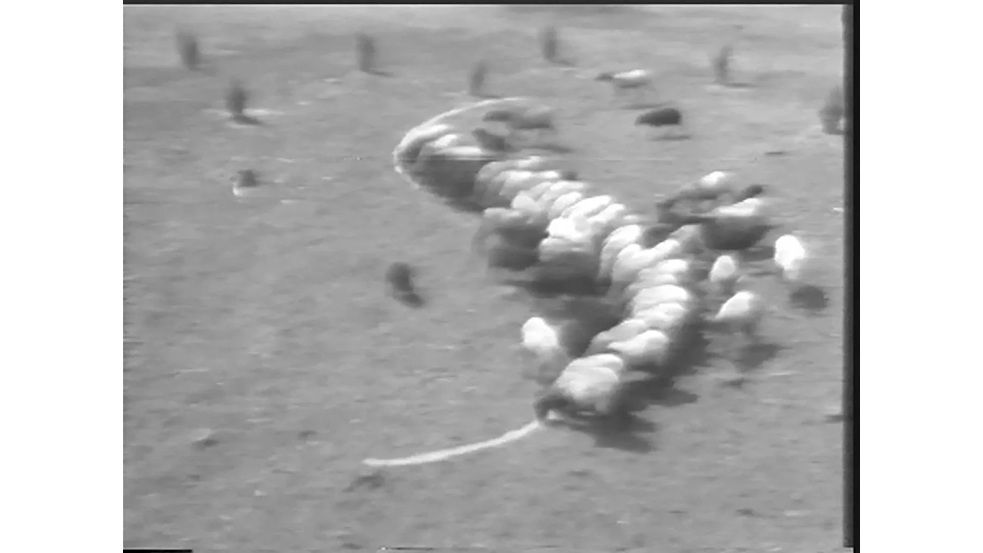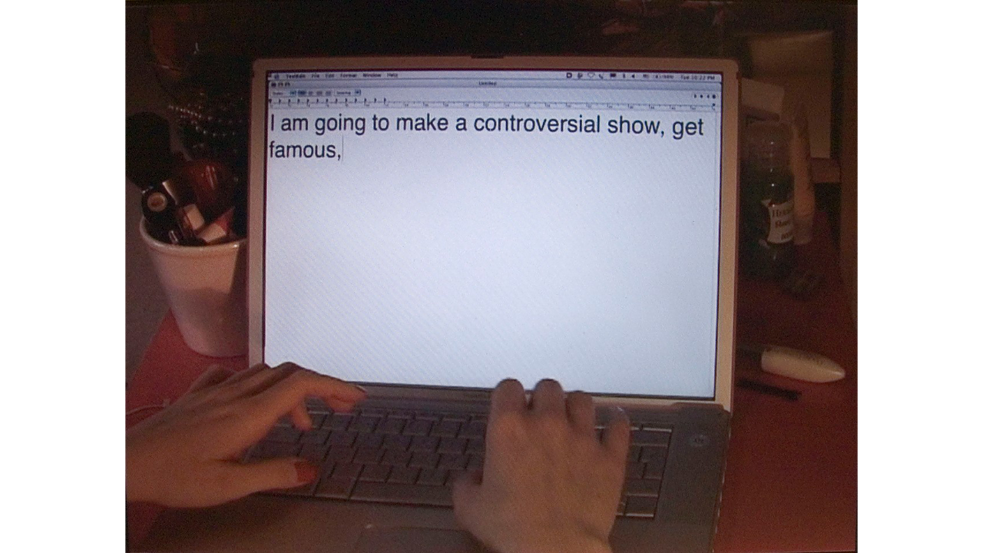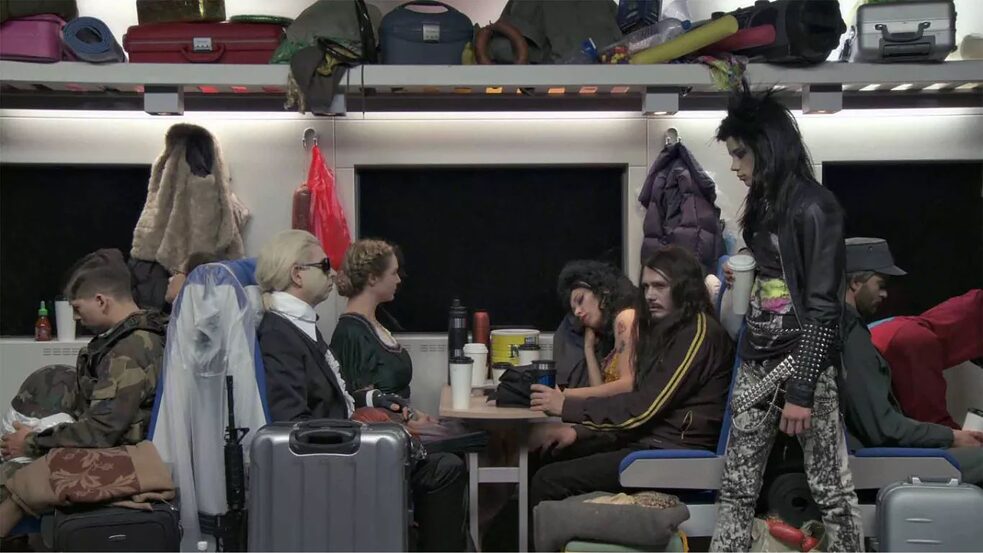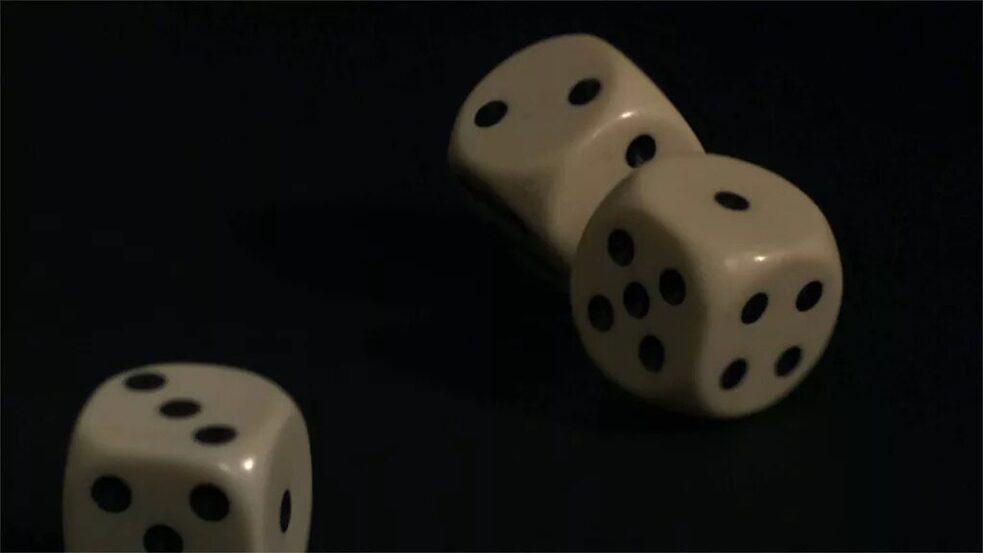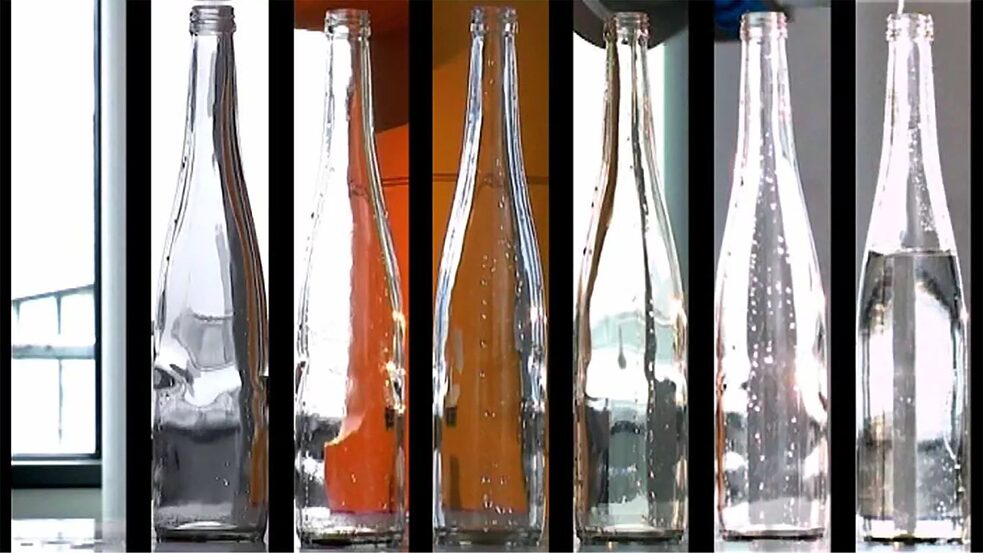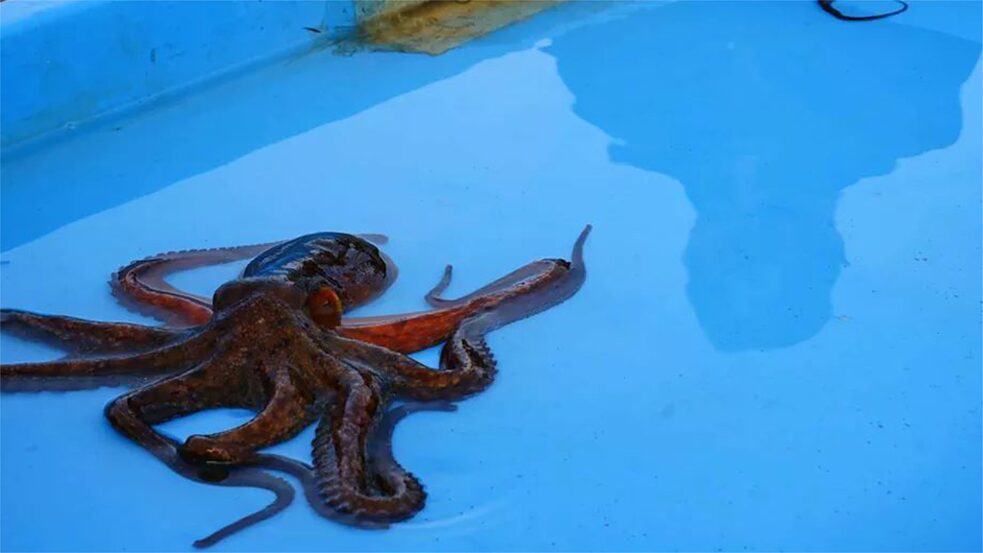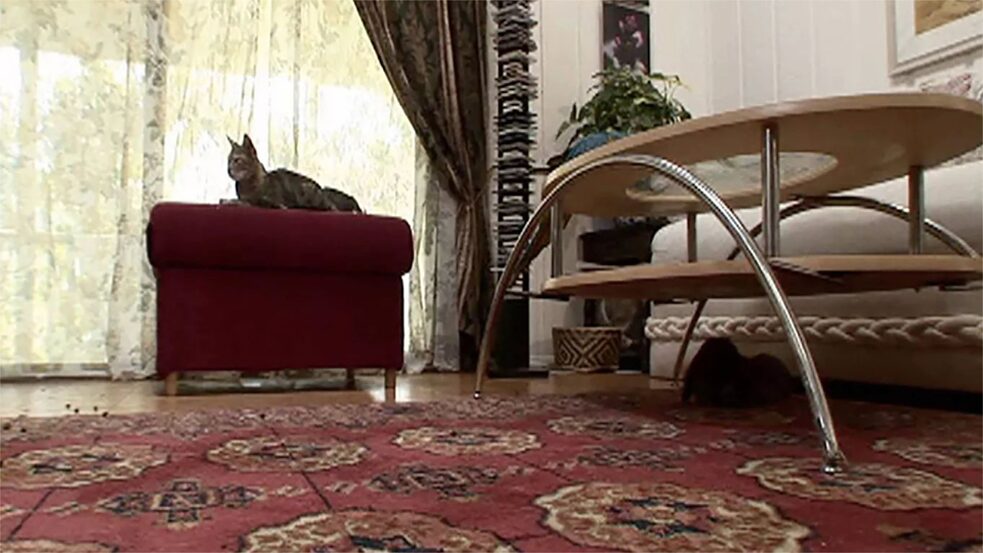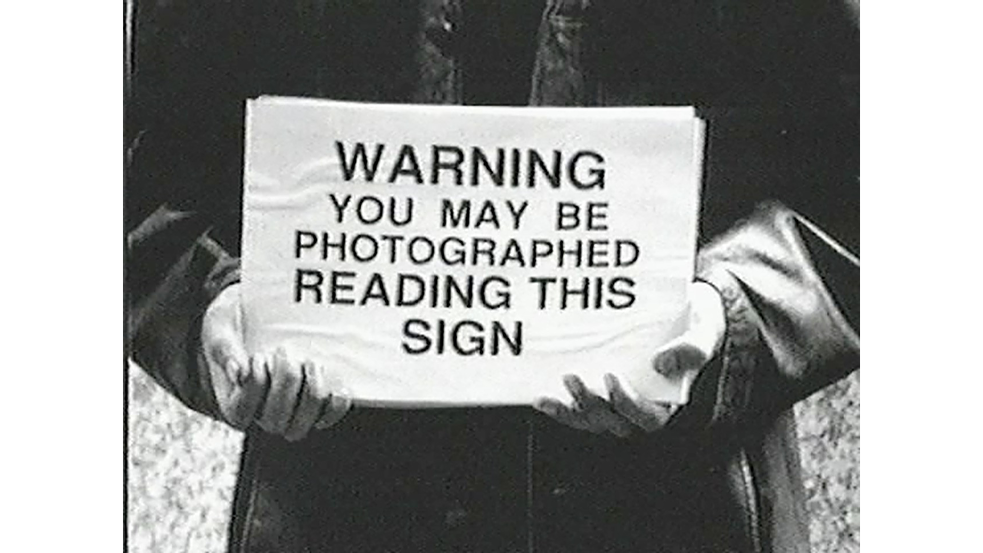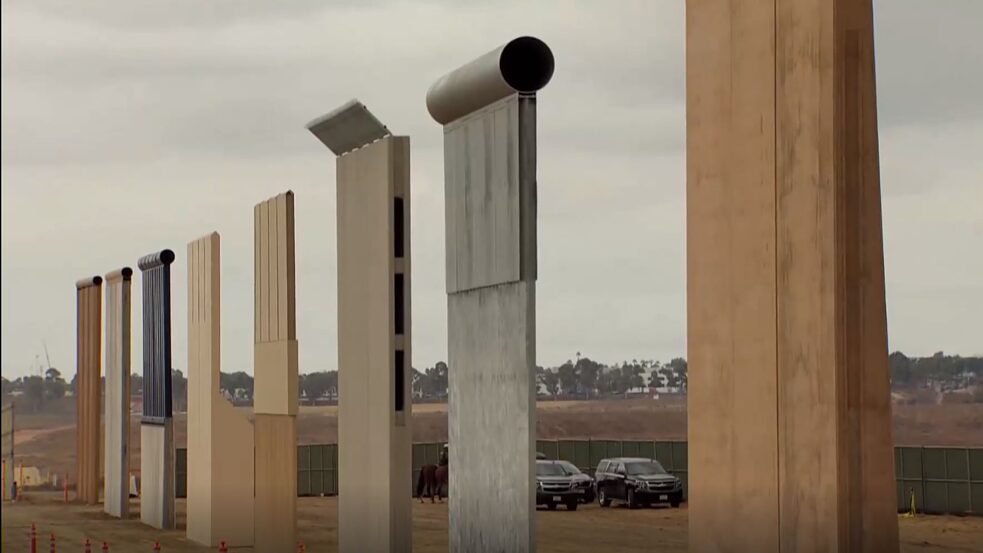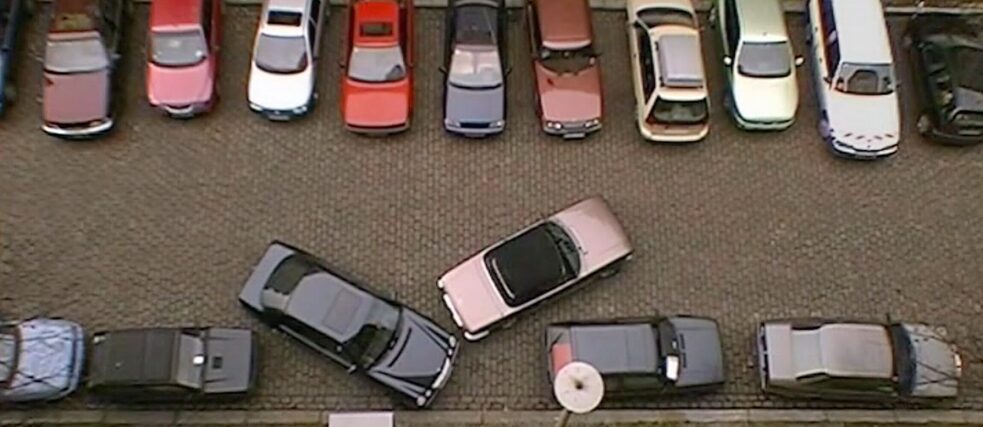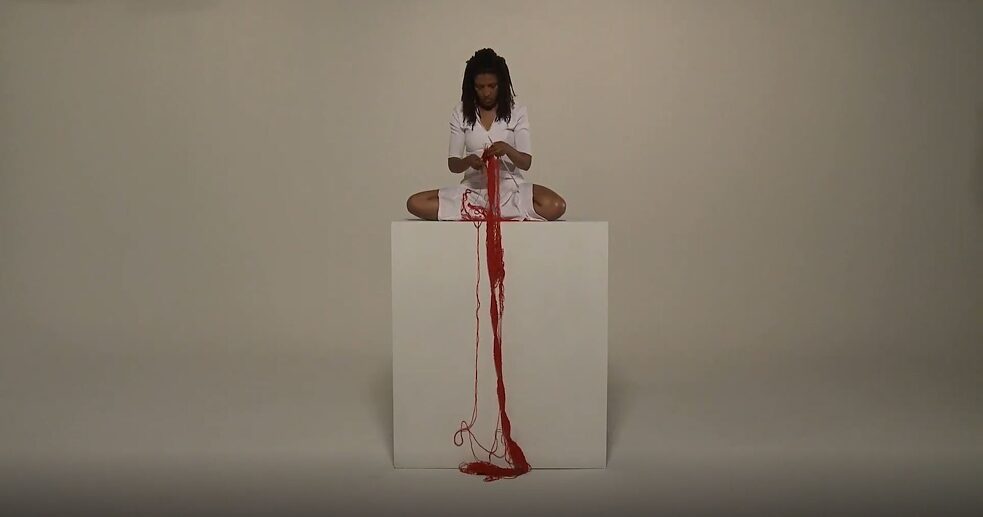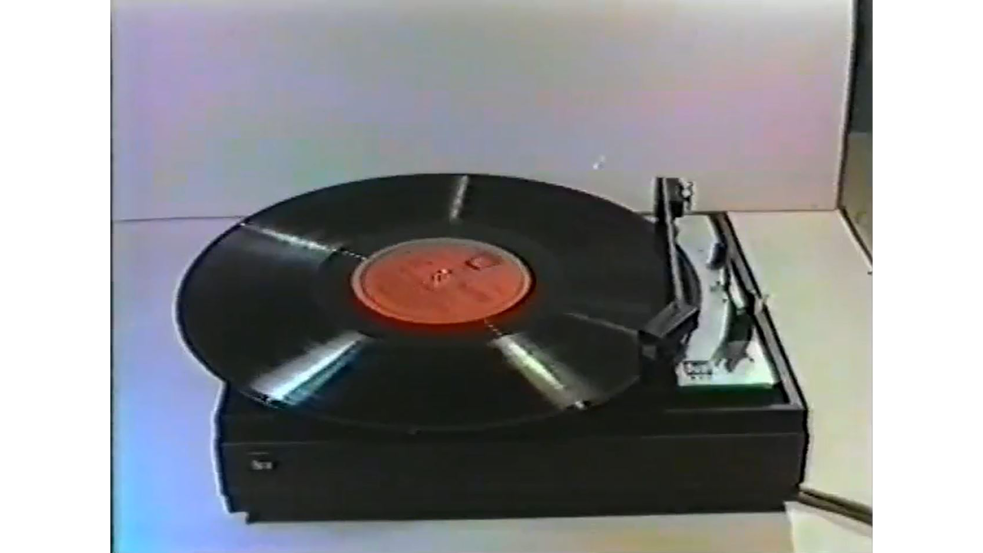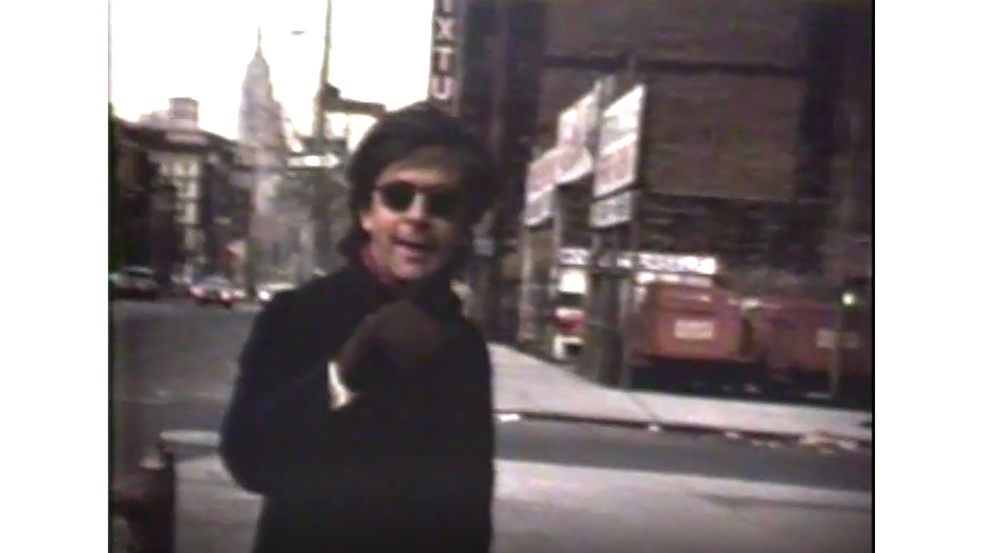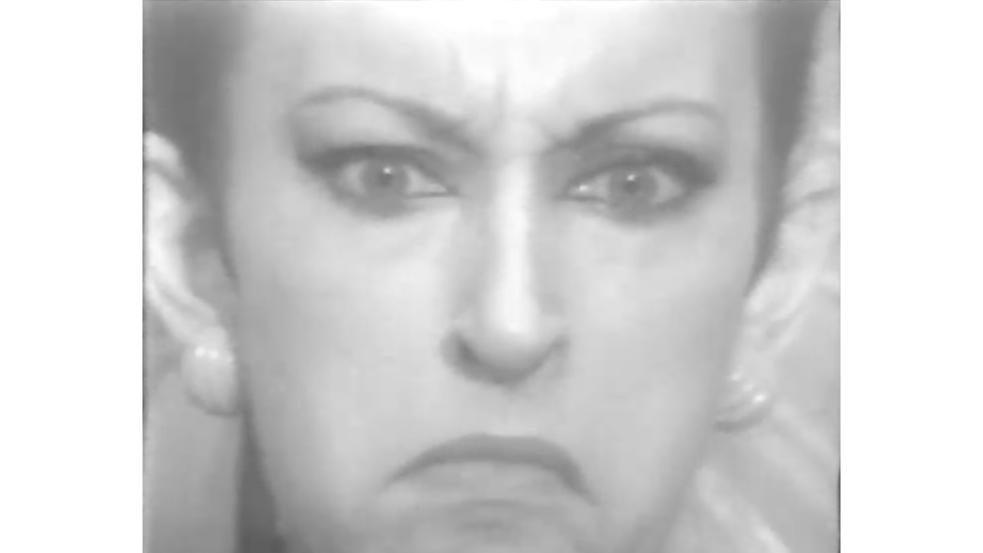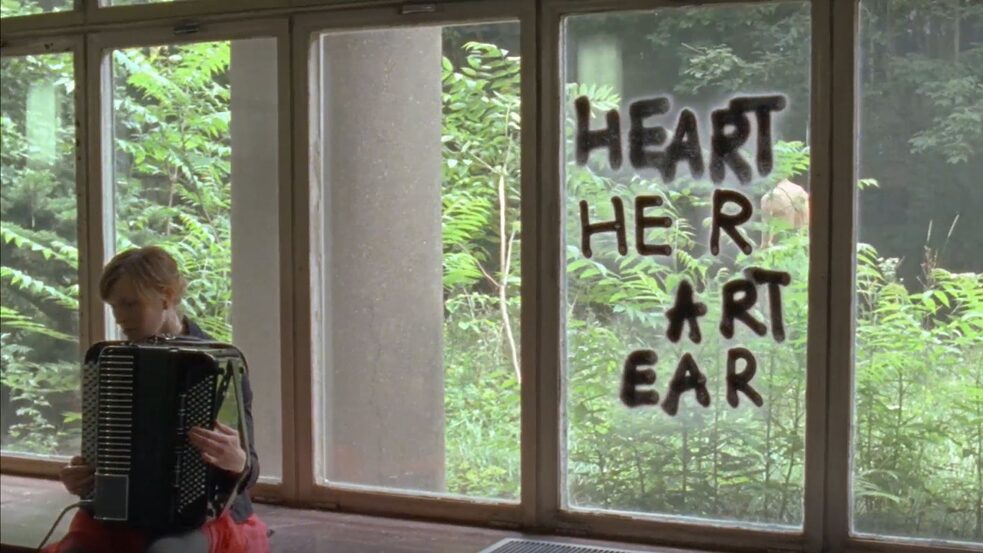On display were videos by renowned artists from Germany, such as Hito Steyerl, Alicia Kwade and Antje Ehmann, who are no strangers to Quebec - but also video works by international artists, such as Pilvi Takala, Richard Serra and Young-Hae Chang Heavy Industries.
On the one hand, the selected works reflect - sometimes critically, but also humorously - the geographical position of the projection screens at the Goethe-Institut Montreal, in the middle of the city, at a busy intersection on Ontario Street and St. Laurent Boulevard, i.e. a place of urban passage, but on the other hand they also represent the diversity of the n.b.k. Video-Forum collection.
The individual films were each be shown for a week from sunset to 2:00 a.m. on the three external projection screens of the Goethe-Institut Montreal at 1626 Boul. St-Laurent, and could be viewed on an indoor screen during the Institut's opening hours.
-
A CRISIS OF EVERYTHING AND NOTHING
YOUNG-HAE CHANG HEAVY INDUSTRIES
2023
35:30
Collection Video-Forum, Neuer Berliner Kunstverein (n.b.k.)
A CRISIS OF EVERYTHING AND NOTHING was produced especially for the n.b.k. Video Forum. In the context of their first German solo exhibition, the artist duo spent several weeks in Berlin in the winter of 2022/23. The work blends real events and encounters from this stay with fictional elements. Starting point is the explosion of a giant aquarium in the atrium of a large hotel in Berlin that provokes an existential crisis in the heroine of the story.
Since its inception in the late 1990s, the Net Art pioneers YOUNG-HAE CHANG HEAVY INDUSTRIES (YHCHI) have developed a distinctive style through its negotiation of cultural identity, material inequalities, (police) violence, the confluence of fact and fiction, and geopolitical realities, including the division of Korea. The works of the art duo are characterized by a high degree of abstraction that simultaneously constitutes its signature: YHCHI’s wide-ranging themes and interests are expressed almost exclusively through writing and a lyrical subject, the text is synchronized by - mostly self-composed - music and builds up sentence by sentence, word by word or letter by letter.
-
S.C.H.A.F.E.
Wolf Kahlen
1975
37:55 min.
In S.C.H.A.F.E., Wolf Kahlen works with a flock consisting of 106 sheep, that throughout the course of the video describe themselves in monumental fashion by successively forming together the individual letters S, C, H, A, F and E. (The German word for “sheep”.) The shape of the respective letter is pre-drawn by oat flakes on the meadow. In each scene, the sheep stream out hurriedly and move closer and closer together until they finally group together to form the corresponding letter. Slowly the letter dissolves again when the food is eaten and some sheep and finally the whole group move on to the next letter in the following scene. In the process, two sheep dogs make sure that all the sheep join. The video explores the process of the formation and deformation of image and language, putting forms of communication to question as externally controlled, collective programming.
The video art pioneer Wolf Kahlen (*1940 in Aachen / Germany, lives in Berlin and Bernau / Germany) is a founding member of the Neuer Berliner Kunstverein’s Video Forum, which opened in 1971 as the Videothek and featured his work Reversible Processes (1971). As an artist who creates three-dimensional intermedia works with video, media, and objects, he calls himself a “media sculptor.” As early as the 1960s, Kahlen’s work critically examined the then-newly emerging mass medium of television. In his video sculptures, for example, he placed mirrors on TVs in order to turn the space of the viewer into the content of the device. He co-founded the Aktionen der Avantgarde (1973–1974) in Berlin and, in 1985, founded the Berlin exhibition space for video and sound art, Ruine der Künste. Kahlen is Professor Emeritus of Multimedia Art at the Technische Universität Berlin.
-
How to Make a Revolution
Anetta Mona Chişa, Lucia Tkáčová
2006
02:55 min.
In their collaborative works, Anetta Mona Chişa and Lucia Tkáčová address gender relations and their own role as Eastern European women artists in a Western-dominated art world. In How to Make a Revolution, the camera is focused on a glowing computer screen in the dim evening light. An anonymous person types on the keyboard the scenario of a future life course, in the form of a list of various measures that are to help achieve a breakthrough in the art world. The master plan depicted not only leads the intimate hopes for a successful career as an artist ad absurdum, but at the same time poses the question of the potential for changing an existing system.
Anetta Mona Chişa (*1975 in Nădlac / Romania, lives in Berlin and Prague) and Lucia Tkáčová (*1977 in Banská Štiavnica / Slovakia, lives in Berlin and Prague) have collaborated since 2000, in addition to their independent practices. Together, they examine processes of transformation in the discourses of art, politics, and gender in post-Communist Europe. Their video performances, installations, and text-based works humorously question the relationships among players in the international art industry and, in particular, the expectations the profit-oriented West places on Eastern European artists. The process of post-Communist transformation, with its multiple fractures and discontinuities, provides the thematic framework for many of their works. -
Strike
Hito Steyerl
2010
00:35 Min.
Strike, Steyerl's shortest film to date, shows a very direct act of media criticism: the artist approaches a black LCD flatscreen with a hammer and chisel, sets to work and shatters it with a well-aimed blow. The cracks in the surface and the resulting mirror effects produce a new, abstract-aesthetic image, which in turn is reminiscent of early experiments in video art. With her impacting gesture, Hito Steyerl reminds us of the physical reality of media images.
Hito Steyerl (*1966 in Munich, lives in Berlin) is one of the most influential artists of our time and has significantly shaped the discourse around the so-called “Documentary Turn” since the 1990s. Both her theoretical texts and artistic works in the mediums of video, film, and performance examine postcolonial and feminist critiques of representation, breaking open and penetrating the documentary through strategies of fictionalization. Her essay films and large-scale video installations investigate the politics of images, questioning aesthetic mechanisms of power while shedding light on political conflicts, social change in our technologized society, and the workings of our capitalist lifeworld. -
SORRY
Stefan Panhans
2010
09:35 min.
SORRY (2010) displays an oppressive scene in a recreated ICE wagon with a single constant camera position. It is a situation that is immediately familiar: a crowded train, all seats are occupied, and the modest luggage racks hopelessly overcrowded. In search of a niche, more and more people are pushing their way through the narrow aisle and back as it doesn't seem to be any better in the back of the car. Along with them they drag XXL coffee mugs and mostly bizarre luggage. The travelers in Panhans' work also appear familiar, as they depict the doppelgangers of various celebrities. The singer Amy Winehouse, the fashion designer Karl Lagerfeld, the artist Jonathan Meese, the singer Bill Kaulitz (Tokio Hotel) and - even several times - the actor Johnny Depp appear. The presence of Lara Croft and SWAT officers in full gear lend the scene an absurd and oppressive surreality. The only spoken word in the video is a short "Sorry" from Johnny Depp, when he accidentally bumps into Bill Kaulitz and apologizes.
In his photographs, videos, text collages, and drawings, Stefan Panhans (*1967 in Hattingen / Germany, lives in Berlin and Hamburg) focuses primarily on phenomena of everyday life in media society and on manifestations of the urban. Based on research and meticulous observations, his works thematize the effects of the media on body and mind, such as the pressure for self-presentation and self-optimization. -
In Ewig den Zufall betrachtend
Alicja Kwade
2014
08:16 Min.
Collection Video-Forum, Neuer Berliner Kunstverein (n.b.k.)
The video installation In Ewig den Zufall betrachtend (engl. Forever contemplating chance) shows dice rolling ceaselessly from left to right without ever stopping. By using the dice as a symbol of luck and throwing it as a method of making decisions or tracking down the outcome of a process, Kwade has found a formally simple, yet strong metaphor for the human pursuit of certainty.
In her sculptures, spatial and light installations, and video works, Alicja Kwade (*1979 in Katowice / Poland, lives in Berlin) repeatedly explores the relationship between fiction and reality. Her works are formal attempts to explain scientific or philosophical phenomena and shed light on our perception of reality as well as social conventions. In this process, Kwade works with material properties, modes of representation, and the expectations associated with them, as well as with notions of time and space. -
Umgießen
Harun Farocki
2010
19:28 Min.
Collection Video-Forum, Neuer Berliner Kunstverein (n.b.k.)
In Umgießen Farocki attempts to adapt the famous Fluxus performance Zyklus für Wassereimer (oder Flaschen) (in English Cycle for Water Buckets [or Bottles]) by Tomas Schmit from 1962 under today's conditions - in this case by a robot. In Schmit's performance a performer surrounded by buckets or bottles of water pours water from one container to the next in a clockwise direction until all the water has evaporated or spilled. For what takes many hours in the original performance Farocki's robot takes only a few minutes, creating a humorous traffic jam.
Farocki manages a humorous inversion of the much-vaunted greater efficiency of machines compared to humans.
Harun Farocki (*1944 in Nový Jičín / Czech Republic, †2014 near Berlin) is one of the most influential German filmmakers in the genre of essay film – his life’s work includes more than 100 experimental and documentary films, essay films, shorts, and feature films. Starting in the mid-1990s, Farocki expanded his cinematic practice to include video installations in visual arts venues. Central to his approach is an investigation of the meaning of images, their creation, and, most importantly, the power structures inscribed within them. His work is concerned with the optics and visualization of violence, as well as the political dimensions of the filmic and the power of technical images. In addition to his artistic activities, Farocki also worked as a writer and editor for the magazine Filmkritik (Film Review), and taught at the University of California, the Deutsche Film- und Fernsehakademie Berlin, the Universität der Künste Berlin, and the Akademie der bildende Künste Vienna. -
e-constellations
Tomas Schmit
2004
24:59 Min.
Collection Video-Forum, Neuer Berliner Kunstverein (n.b.k.)
The interplay of words and images is of particular importance in Tomas Schmit’s work. His late work e-constellations (2004) consists of 200 simple drawings of yellow fixed points and white connecting lines on a black background. Like a mobile, the points and lines constantly give rise to new permutations. Presented one after the other as a digital slide show, they function like a “school of seeing” and are titled by the artist with English terms in a process reminiscent of puzzle games and the interpretation of constellations. Schmit recorded the audio track to e-constellations in one take in his apartment on Linienstrasse 158 in Berlin. Intermittent street noises or scraps of conversation are audible in the background. E-constellations provided Schmit the impetus for a series of further works in which he used audio recordings and the computer as an imaging medium.
As a pioneer of the Fluxus movement of the 1960s, Tomas Schmit (*1943 in Wipperfürth / Germany, †2006 in Berlin) played a significant role in the radical questioning of bourgeois art and the emergence of a new aesthetic. In his artistic practice, which primarily focused on drawing from 1970 onwards, he humorously explored language, logic, paradox, biology, behavioral research, and perception, taking concrete observations of everyday life as a starting point. -
Worker's Forum
Pilvi Takala
2015
31:55 Min.
Collection Video-Forum, Neuer Berliner Kunstverein (n.b.k.)
Workers’ Forum is an animated message conversation based on the experiences made by Pilvi Takala (*1981 in Helsinki, lives and works in Berlin and Helsinki) as a microtasker in the United States. Microtaskers are low-cost, part-time workers paid by online enterprises to perform small chunks of large jobs without special training or prior knowledge. Depending on the task, a group or a mass of individuals is recruited to complete the work. Takala worked for a service where users pay for a pretend girlfriend or boyfriend to text them. The task to be performed was: “Write a text message that is positive, engaging, and convincingly written in the voice of someone texting a significant other.” The video is based on conversations in a discussion forum between the microtaskers trying to figure out how to be an invisible partner. The workers express genuine concern about the users, even though they are underpaid and working within a system designed to minimize and hinder human connection and care.
Pilvi Takala (*1981 in Helsinki, lives and works in Berlin and Helsinki) uses performative interventions as a means to process social structures, questioning normative rules and truths of our behavior in different cultural contexts. Pushing the boundaries of various genres – including documentary film and performance –, Takala’s works shed light on the implicit rules of social situations which often only become visible through their disruption. -
Labour in a Single Shot: Marseille. Portrait of a city composed by Labour-in-a-Single-Shot films
Antje Ehmann, Eva Stotz
2018
36:13 min.
Collection Video-Forum, Neuer Berliner Kunstverein (n.b.k.)
Labour in a Single Shot is based on workshops conducted around the world, where participants produce one- to two-minute videos recorded in a single shot. The camera can be static, panning, or moving – the only prerequisite is that there are no cuts. Their object of investigation is work in its many and varied forms: paid or unpaid, material or immaterial, traditional or new forms of labor in the digital sector. The topic of cinematic work itself, various methods of image production, and collective work are further themes addressed in Labour in a Single Shot. Marseille. Portrait of a City, composed of Labour-in-a-Single-Shot films, was created in 2018 during a workshop in Marseille and consists of 20 individual portraits of the following occupations: film projectionist, knife sharpener, orange vendor, bodybuilder, fish pedicurist, technician, fishmonger, hairdresser, helper for illiterate people, animal vendor, video editor, firefighter, writer, construction machine operator, butcher, tailor, clothes sorter, construction worker, musician, street sweeper.
Antje Ehmann (*1968 in Gelsenkirchen, lives in Berlin) is a curator, writer, and artist. She has addressed the history of film and urban development in numerous exhibitions, artistic projects, and publications. Until her death in 2014, Ehmann also worked together with filmmaker and author Harun Farocki, with whom she initiated the serial project Labour in a Single Shot in 2011. Stotz and Ehmann have continued Labour in a Single Shot since 2017.
Eva Stotz (*1979 in Isny, lives in Berlin) is a documentary filmmaker and director whose works include examinations of the effects of globalization. -
Once Upon a Time
Corinna Schnitt
2006
25:11 min.
Collection Video-Forum, Neuer Berliner Kunstverein (n.b.k.)
With Once upon a Time, Corinna Schnitt transforms a middle-class living room into a tragicomic setting occupied by cats, dogs, parrots, rabbits, llamas and cows. A camera set up on the floor, scanning the room in a 360-degree rotation, documents how the domesticated order is gradually turned upside down. While the animals make the found space their own, at the same time one cannot help but read their behaviour and interactions as symbolic moments for a social togetherness.
In her video work, Corinna Schnitt (*1964 in Duisburg / Germany, lives in Braunschweig / Germany) often focuses on seemingly casual but elaborately staged observations of everyday life in the bourgeoisie – its norms, peculiarities, and absurdities – which she ironically illuminates at the interface between documentary and fiction. The relationships of people to each other and to nature are recurring motifs in Schnitt’s videos.
-
In the event of amnesia the city will recall...
Denis Beaubois
1997
09:59 Min.
Collection Video-Forum, Neuer Berliner Kunstverein (n.b.k.)
The video work In the event of amnesia the city will recall… was born out of a three day operation in the public space of Sydney, in which the Denis Beaubois positioned himself at twelve different locations across from security cameras, which he took to be his intended audience. The artist began to interact with the security cameras and used inscribed cardboard signs to enter into a dialogue with them. Through skillful editing, e.g. the use of shot-reverse shot, Beaubois succeeds in giving the impression that the cameras react to his attempts at communication. For example, when the camera moves from left to right, it is read as the denial of a question by shaking one’s head. Beaubois satirizes the alleged pursuit of safety of the Society of Control in that he points its technology back at itself in a humorous way.
The work of Denis Beaubois (*1970 in Moka / Mauritius, lives in Sydney) includes photography, video, and performance, which the artist sometimes realizes as part of collectives including the Post Arrivalists and Gravity Feed, a performance theater at the intersection between fine art, architecture, and theater. -
Positions
Kristina Paustian
2016
08:22 min.
Collection Video-Forum, Neuer Berliner Kunstverein (n.b.k.)
A group of young women sit on the roof of a skyscraper in front of a skyline. Uniformed and armed, they point their guns at a target that lies outside the frame and remains hidden from the viewers. Instead, the camera focuses on the postures and facial expressions of the protagonists. With Positions, Kristina Paustian presents an aesthetic study of forms of resistance - both against political systems and normative gender concepts.
Kristina Paustian (*1985 in Omsk / Russia, lives in Berlin) works with video art, film, video installation, and video performance and is a founding member of UNST, a collective of media artists, curators, and academics dedicated to the development of experimental exhibition formats for time-based media. Paustian examines cultural-anthropological and sociopolitical issues in her work, exploring the complexity of seeing and being seen. Her films engage with identity and memory politics and the staging of gender roles and feminism, as well as bodily gestures and the appropriation of behavioral norms. -
Eli Cortiñas
Walls Have Feelings
2019
13:12
Collection Video-Forum, Neuer Berliner Kunstverein (n.b.k.)
In Walls Have Feelings, Eli Cortiñas addresses the power that objects and architectures have to effect change in the worlds of politics and labor. The film’s protagonists are office spaces, walls, artworks, and technological entities, which appear as authority figures or preservers and amplifiers of various forms of power. Starting from the design of space in totalitarian systems, this essayistic narrative takes the objects’ point of view to draw connections between structures of political domination, industrial production conditions, and neoliberal systems of value creation.
About the Artist
Visual memory is challenged in the works of Eli Cortiñas (*1979 in Las Palmas de Gran Canaria, lives and works in Berlin). The film and video artist analyzes preexisting film footage from advertising, film, and pop culture then reworks and recontextualizes it through slight alterations or juxtaposition with the artist’s own recordings. -
Boomerang
Nancy Holt, Richard Serra
Boomerang
1974
10:55
Collection Video-Forum, Neuer Berliner Kunstverein (n.b.k.)
Nancy Holt, the main figure in Richard Serra’s video, is connected to the outside world with a microphone and headphones in two signal directions. While she is speaking in front of the camera, her headphones are playing her words with a delay of one second. Through a monologue of self-observation, she is describing her relationship with herself as being caught in a “world of double reflections and refractions.” She attempts to grant expression to an experience that corresponds to the complete technical mediatization of a lifeworld: she feels alienated from herself, which takes on a discursive form in this conceptual video.
Since the 1960s, Richard Serra (*1939 in San Francisco / USA, lives in New York and Nova Scotia / Canada) has been known primarily as a sculptor of monumental statues in outdoor spaces. To create his sculptures, he works with industrial materials such as lead and rubber, iron and steel. In this process, both the quality of the material and the relationship to space form central elements of his works. Together with Nancy Holt (*1938 in Worcester / USA, †2014 in New York), a pioneer of site-specific installation and the experimental moving image, a joint video work was created. In addition to works in the realm of land art and large-scale installations in public space, Holt experimented with photography and video, especially at the beginning of her career. -
Parken
Asta Gröting
2001
04:37
Collection Video-Forum, Neuer Berliner Kunstverein (n.b.k.)
PARKEN is representative of Asta Gröting's artistic approach of exploring interpersonal relationships on an emotional and conceptual level. A narrow street framed by two rows of parked cars is all that the fixed camera captures from a bird's eye view. At times, a car drives out, creating a free parking space for which several drivers instantly compete. The vehicles navigate hectically and nervously through the narrow street, pushing forward and blocking each other. The movements reveal a spectrum of tactics that symbolize the competition in a neoliberal working society.
Asta Gröting (*1961 in Herford / Germany, lives in Berlin) investigates the human body as a site of internal and external communication by means of the people around her and her own psyche. Referencing the readymade and the development of post-1960s material aesthetics, she engages with the language of everyday life both theoretically and artistically, visualizing complex issues of human coexistence from the perspective of cultural and scientific history. Although her work initially focused on sculpture, she began to explore the potential of the moving image in 1993. -
Selogilwe
Lerato Shadi
2010
07:03:56
Collection Video-Forum, Neuer Berliner Kunstverein (n.b.k.)
Selogilwe is a seven hours performance, which is conceptualized for video and filmed in an uninterrupted shot. For the whole duration of the video Shadi sits on a white plinth and knits a red woolen string that seems to emerge from her belly button and resembles an umbilical cord. In Setswana, the term "Selogilwe" means "woven" and can be understood both specifically in relation to the repetitive act of knitting and in relation to the passing of time, the duration of which is materialized in the ever-lengthening knitted wool. As time progresses, the red knitted fabric becomes longer, while at the same time the fatigue and fidgeting of the performer become more pronounced and a physical rendering of time occurs.
The video, performance, and installation artist Lerato Shadi (*1979 in Mafikeng / South Africa, lives in Berlin and Johannesburg) studied fine art at the University of Johannesburg and the Kunsthochschule Berlin-Weißensee. Her practice examines discourses of inclusion and exclusion and the visibility of People of Color, criticizing purely Western notions of history. Shadi places her body at the center of her work – often in long, physically demanding performances that address the violence of images, as well as questioning monumentality and gender. -
Record Archive on Videotape
Claus Böhmler
1987
03:04:00
Collection Video-Forum, Neuer Berliner Kunstverein (n.b.k.)
Produced in 1987, Record Archive on Videotape shows a single camera shot of a record player in operation, on which the artist plays various records in their entirety over a period of 184 minutes. The audio recordings are briefly interrupted by the intervention of the artist’s hand as he changes the record. We hear a colorful mix of musical, ethnological, political, and natural history recordings, which sometimes cite other media forms, such as the soundtrack from the Hitchcock classic Psycho and recordings of the The Ed Sullivan Show, a former television variety show in the United States. The video works like a guide through an open journey of associations and ideas, which reveal myriad influences and sensory approaches to spaces of memory in a manner that is both simple and poignant.
Claus Böhmler (*1939 in Heilbronn, †2017 in Hamburg) created an exuberant body of work in over 50 years of artistic activity. Böhmler worked across different media, especially with drawings, which he often animated as videos. He also worked with language, electronic media, and installations. Böhmler’s work exudes a sense of experimentation and humor and can be considered part of the Fluxus movement. From 1974 to 2005, Böhmler was a professor of fine arts at Hochschule für Bildende (HFBK) in Hamburg. -
I am an Artist
Les Levine
1975
16:37
Collection Video-Forum, Neuer Berliner Kunstverein (n.b.k.)
In his video I am an Artist, Les Levine walks the streets of New York and insists on a “pure” concept of art: he’s an artist, and thus could not get involved. Yet he constantly adresses the camera following him with his monologue as well as curious passersby. By playing with communicative structures Levine, in his work constantly questions the social system that is art with ironic and provocative statements.
The conceptual work of video and media art pioneer Les Levine (*1935 in Dublin, lives in New York) centers on playing with structures of communication. He understands art as a social system, which he repeatedly challenges with ironic and provocative positions. Levine shot his first videos with the Sony Portapak camera as early as the mid-1960s, and he created the first closed-circuit video installation in 1968. -
Video - Ich sehe mich / Mimikry
(Excerpt)
Michael Geißler / Rosalia Müller
1977
00:06:55
Collection Video-Forum, Neuer Berliner Kunstverein (n.b.k.)
The work Mimikry by Rosalia Müller is part of the video series Video - Ich sehe mich (engl.: Video – I see Me) from 1977 with several short works by individuals, alone in front of the camera, that each emphasizes the performative potential of the medium for self-presentation. The series was produced and conceived by the German artist Michael Geißler, who founded the collective "VAM" (Video-Audio-Media) in 1969. VAM developed an independent, documentary video style that was both playful and imaginative. VAM were the first video project whose productions were broadcast on German television and took part in Documenta 6 in 1977. In Mimikry, the artist Rosalia Müller demonstrates in a humorous way how one can work on one's own image and expression with the help of a camera. Müller's work is an approximately 7-minute excerpt from the original video series, which is 1:02:30 minutes long.
Michael Geißler (*1942 in Berlin, †2003 in Berlin) belongs to the first generation of video artists in Germany. He was part of the founding class of the Deutsche Film- und Fernsehakademie in Berlin. In 1969, he formed the video artists’ collective VAM (an acronym for Video, Audio, Media). With a changing line-up, the group developed an independent, documentary, and playful video style that examined social and sociopolitical issues. In total, Geißler was involved in around 370 video productions. -
To Valerie Solanas and Marilyn Monroe in Recognition of their Desperation
Pauline Boudry / Renate Lorenz
2013
00:13:56
Collection Video-Forum, Neuer Berliner Kunstverein (n.b.k.)
In the video work To Valerie Solanas and Marilyn Monroe in Recognition of their Desperation (2013), six performers play the eponymous score from 1970 by the US avant-garde composer and sound artist Pauline Oliveros (1932–2016). Oliveros developed the piece after reading the radically feminist SCUM Manifesto (1967) by Valerie Solanas, who later became famous as the woman who shot Andy Warhol. The composition challenges the performers, Rachel Aggs, Peaches, Catriona Shaw, Verity Susman, Ginger Brooks Takahashi, and William Wheeler, to choose five pitches each and to play very long tones, either modulated or unmodulated. In the middle section of the piece the performers are invited to imitate each other’s pitches and modulations, whereas they interact not only with each other and their instruments, but also with the iconic GDR architecture of the Funkhaus Berlin from 1951.
The piece To Valerie Solanas and Marilyn Monroe in Recognition of their Desperation aims to avoid the hierarchies between musicians. Its instructions are designed to create a “continuous circulation of power” (Oliveros) between listening and sounding. The cues in the piece are given collectively through light: a red section is followed by a yellow section and then a blue section, and two further cues are given by strobe light.
Pauline Boudry (*1972 in Lausanne / Switzerland) and Renate Lorenz (1963 in Berlin) live in Berlin and have worked together since 2007. Their artistic practice manifests itself in films, performances, songs, objects, and texts. They collaborate with dancers, choreographers, and visual artists with whom they share a long history of dealing with conditions of performance and violent hierarchies of bodies, but also of companionship, glamour, and resistance. -
A CRISIS OF EVERYTHING AND NOTHING
YOUNG-HAE CHANG HEAVY INDUSTRIES
2023
35:30
Collection Video-Forum, Neuer Berliner Kunstverein (n.b.k.)
A CRISIS OF EVERYTHING AND NOTHING was produced especially for the n.b.k. Video Forum. In the context of their first German solo exhibition, the artist duo spent several weeks in Berlin in the winter of 2022/23. The work blends real events and encounters from this stay with fictional elements. Starting point is the explosion of a giant aquarium in the atrium of a large hotel in Berlin that provokes an existential crisis in the heroine of the story.
Since its inception in the late 1990s, the Net Art pioneers YOUNG-HAE CHANG HEAVY INDUSTRIES (YHCHI) have developed a distinctive style through its negotiation of cultural identity, material inequalities, (police) violence, the confluence of fact and fiction, and geopolitical realities, including the division of Korea. The works of the art duo are characterized by a high degree of abstraction that simultaneously constitutes its signature: YHCHI’s wide-ranging themes and interests are expressed almost exclusively through writing and a lyrical subject, the text is synchronized by - mostly self-composed - music and builds up sentence by sentence, word by word or letter by letter.
-
S.C.H.A.F.E.
Wolf Kahlen
1975
37:55 min.
In S.C.H.A.F.E., Wolf Kahlen works with a flock consisting of 106 sheep, that throughout the course of the video describe themselves in monumental fashion by successively forming together the individual letters S, C, H, A, F and E. (The German word for “sheep”.) The shape of the respective letter is pre-drawn by oat flakes on the meadow. In each scene, the sheep stream out hurriedly and move closer and closer together until they finally group together to form the corresponding letter. Slowly the letter dissolves again when the food is eaten and some sheep and finally the whole group move on to the next letter in the following scene. In the process, two sheep dogs make sure that all the sheep join. The video explores the process of the formation and deformation of image and language, putting forms of communication to question as externally controlled, collective programming.
The video art pioneer Wolf Kahlen (*1940 in Aachen / Germany, lives in Berlin and Bernau / Germany) is a founding member of the Neuer Berliner Kunstverein’s Video Forum, which opened in 1971 as the Videothek and featured his work Reversible Processes (1971). As an artist who creates three-dimensional intermedia works with video, media, and objects, he calls himself a “media sculptor.” As early as the 1960s, Kahlen’s work critically examined the then-newly emerging mass medium of television. In his video sculptures, for example, he placed mirrors on TVs in order to turn the space of the viewer into the content of the device. He co-founded the Aktionen der Avantgarde (1973–1974) in Berlin and, in 1985, founded the Berlin exhibition space for video and sound art, Ruine der Künste. Kahlen is Professor Emeritus of Multimedia Art at the Technische Universität Berlin.
About the project
Founded in 1969 in Berlin, the Neue Berliner Kunstverein (n.b.k.) is dedicated to promoting contemporary art.
The project was prompted by the anniversaries of the collaborating institutions - in 2022 the Goethe-Institut Montreal celebrated its 60th anniversary, and in 2021 the n.b.k. Video Forum looked back on 50 years of activity. Founded in 1971 on the initiative of artists and cultural producers in Berlin, the Video-Forum is the oldest and largest video art collection in Germany with 1,700 works of international video art. The collection focuses on Fluxus, feminist video practice, historical and contemporary video art from Berlin and media-reflexive approaches.
Anna Lena Seiser
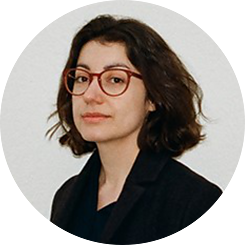 Anna Lena Seiser
| © Ina Niehoff
Anna Lena Seiser is managing director of Neuer Berliner Kunstverein (n.b.k.) and head of the n.b.k. Video-Forum, the oldest and one of the biggest public video art collections in Germany. From 2015–2019 she was curator at Kunsthalle Düsseldorf, where she implemented extensive solo and group exhibitions with international artists. Previously, from 2011–2015 Seiser worked for the German Academic Scholarship Foundation as well as for the postgraduate Karl Schmidt-Rottluff Scholarship program for Visual Artists. She was part of the program team of transmediale - festival for arts and digital culture in Berlin in 2009–2010. Seiser is author and editor of several catalogues. Her recent projects include solo exhibitions and site-specific installations with a. o., Rosa Barba, Loretta Fahrenholz, Claire Fontaine, Simon Fujiwara, Sharon Hayes, Christine Sun Kim and Thomas Mader, Laura Lima, Cinthia Marcelle, Megan Rooney, Natascha Sadr Haghighian, Karin Sander or Sung Tieu.
Anna Lena Seiser
| © Ina Niehoff
Anna Lena Seiser is managing director of Neuer Berliner Kunstverein (n.b.k.) and head of the n.b.k. Video-Forum, the oldest and one of the biggest public video art collections in Germany. From 2015–2019 she was curator at Kunsthalle Düsseldorf, where she implemented extensive solo and group exhibitions with international artists. Previously, from 2011–2015 Seiser worked for the German Academic Scholarship Foundation as well as for the postgraduate Karl Schmidt-Rottluff Scholarship program for Visual Artists. She was part of the program team of transmediale - festival for arts and digital culture in Berlin in 2009–2010. Seiser is author and editor of several catalogues. Her recent projects include solo exhibitions and site-specific installations with a. o., Rosa Barba, Loretta Fahrenholz, Claire Fontaine, Simon Fujiwara, Sharon Hayes, Christine Sun Kim and Thomas Mader, Laura Lima, Cinthia Marcelle, Megan Rooney, Natascha Sadr Haghighian, Karin Sander or Sung Tieu.
